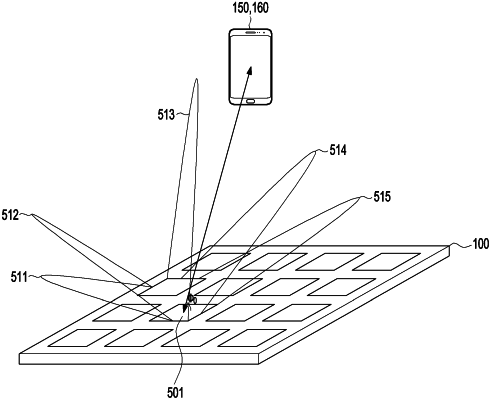| CPC H02J 50/20 (2016.02) [H02J 50/40 (2016.02); H02J 50/80 (2016.02); H02J 50/90 (2016.02)] | 10 Claims |

|
1. A wireless power reception device comprising:
at least one power reception antenna configured to sequentially receive a plurality of different RF waves formed by a wireless power transmission device;
a communication circuit; and
at least one processor,
wherein the at least one power reception antenna is configured to receive the plurality of different RF waves formed based on a sub-RF wave formed on a first antenna among a plurality of power transmission antennas of the wireless power transmission device and sub-RF waves sequentially formed on a second antenna among the plurality of power transmission antennas for a certain period in at least part of an operation of sequentially receiving the plurality of different RF waves,
wherein the at least one processor is configured to:
identify a plurality of pieces of strength information indicating respective strengths of the plurality of different RF waves,
identify a plurality of pieces of phase information corresponding to respective ones among the plurality of different RF waves,
identify, based on the plurality of pieces of strength information and the plurality of pieces of phase information, an optimum phase value which allows a received RF wave to have a maximum strength, and
transmit a communication signal including information about the optimum phase value to the wireless power transmission device through the communication circuit,
wherein the at least one power reception antenna is configured to receive a first RE wave formed based on a sub-RF wave having the optimum phase value formed by the second antenna in response to the at least one processor transmitting the communication signal including the information about the optimum phase value to the wireless power transmission device through the communication circuit,
wherein, based on the at least one processor transmitting the communication signal including the information about the optimum phase value through the communication circuit, the at least one power reception antenna is configured to receive a plurality of different second RF waves formed based on a plurality of different sub-RF waves by a third antenna among the plurality of power transmission antennas while continuously receiving the first RF wave,
wherein the at least one processor is further configured to:
identify a plurality of pieces of second strength information indicating respective strengths of the plurality of different second RF waves,
identify a plurality of pieces of second phase information corresponding to respective ones among the plurality of different second RF waves,
identify a second optimum phase value which allows an RF wave received from the third antenna to have a maximum strength based on the plurality of pieces of second strength information and the plurality of pieces of second phase information, and
transmit a second communication signal including information about the second optimum phase value to the wireless power transmission device through the communication circuit, and
wherein the at least one power reception antenna is configured to receive a third RF wave formed based on a sub-RF wave having the second optimum phase value formed by the third antenna in response to the transmitted second communication signal while receiving the sub-RF wave from the first antenna and receiving the RF wave having the optimum phase value from the second antenna.
|